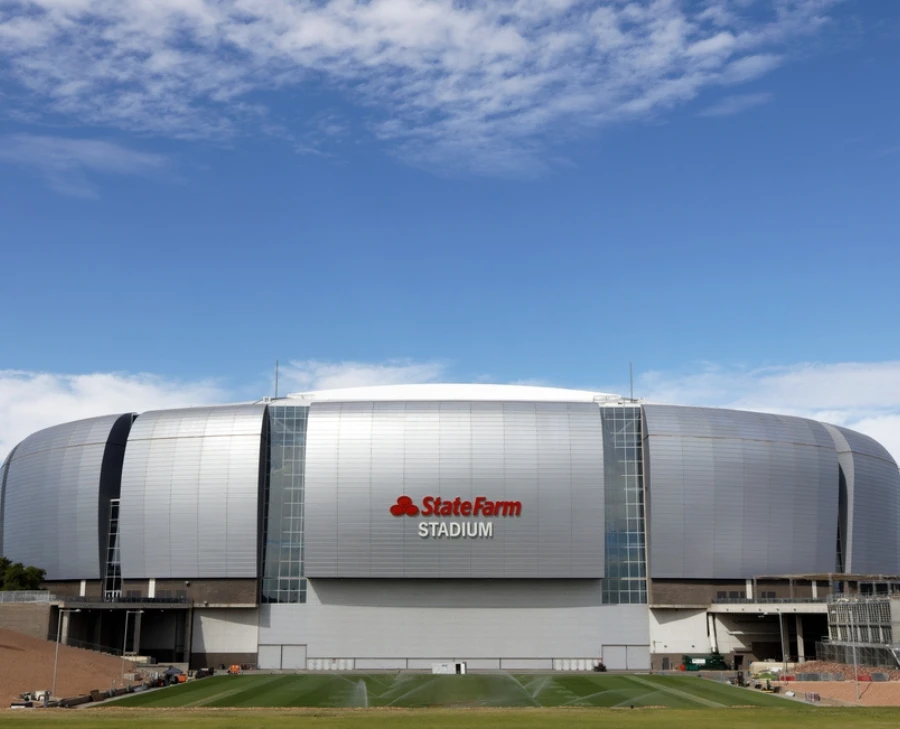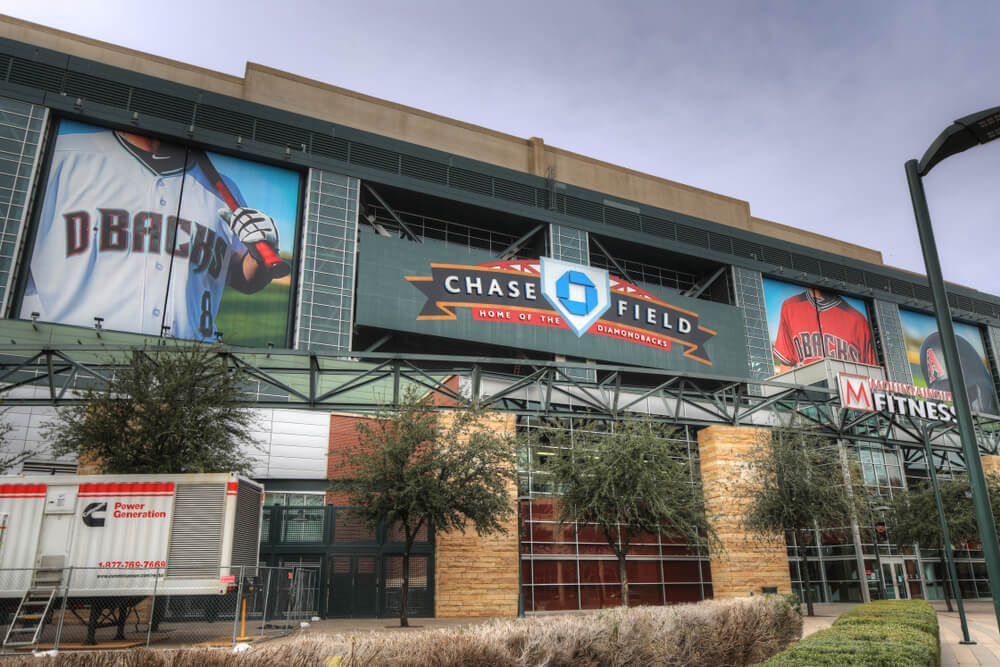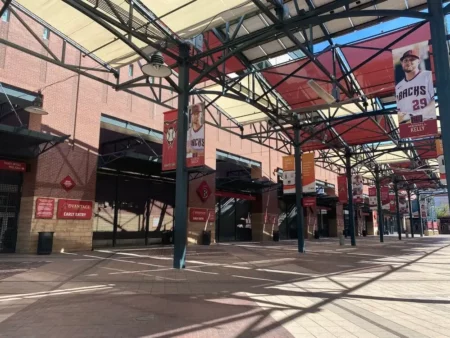Arizona boasts a rich history in sports, with its stadiums and arenas serving as iconic landmarks across the state. From football to baseball, basketball to hockey, these venues not only provide a stage for top-level athletes to compete but also offer unforgettable experiences for fans. This article will explore some of the most prominent sporting venues in Arizona, delving into their history, architecture, and significance.
Importance of Stadiums and Arenas in Arizona
These stadiums and arenas play a vital role in the local economy, driving tourism and creating jobs while fostering a sense of community and pride. As gathering places for fans to celebrate and share their passion for sports, these venues have helped shape Arizona’s cultural identity. Read on to discover the impact and stories behind State Farm Stadium, Chase Field, Talking Stick Resort Arena, and other remarkable sporting venues in Arizona.
State Farm Stadium

History and development
State Farm Stadium, located in Glendale, Arizona, opened its doors in 2006 as the University of Phoenix Stadium. It was renamed in 2018 after State Farm acquired the naming rights. The stadium was designed by the architectural firm Populous, featuring a retractable roof and a first-of-its-kind retractable natural grass playing surface. The venue has hosted numerous high-profile events, including NFL Super Bowls, NCAA Final Fours, and concerts.
Architectural highlights
The stadium’s unique design has earned it several awards and recognitions, including the title of “Best NFL Stadium” by Stadium Journey Magazine in 2017. Its retractable roof and movable field allow for optimal playing conditions and a comfortable fan experience, regardless of the weather. Additionally, the stadium’s striking exterior, resembling a barrel cactus, pays homage to the Arizona landscape and contributes to its iconic status.
Home of the Arizona Cardinals
As the home field of the NFL’s Arizona Cardinals, State Farm Stadium has seen many memorable moments in the team’s history, including thrilling victories and hard-fought playoff battles. The venue’s cutting-edge amenities and spacious seating capacity of 63,400, expandable to 72,200, make it a favorite among Cardinals fans and an essential part of the game-day experience.
Impact on the fan experience
State Farm Stadium’s innovative design and state-of-the-art facilities ensure an unforgettable experience for fans. With ample concession stands, comfortable seating, and unobstructed views, the stadium offers a premier environment to enjoy live sporting events. Furthermore, its proximity to entertainment districts and convenient access to public transportation make it an attractive destination for visitors from near and far.
Economic contributions
State Farm Stadium has been a significant economic driver for the city of Glendale and the surrounding areas, generating millions of dollars in revenue through ticket sales, concessions, and tourism. The venue’s ability to host marquee events, such as the Super Bowl and the NCAA Final Four, has further contributed to its economic impact, attracting visitors from around the world and supporting local businesses.
Chase Field

History and development
Chase Field, originally known as Bank One Ballpark, opened in 1998 in downtown Phoenix. This impressive stadium is home to Major League Baseball’s Arizona Diamondbacks. Designed by the architectural firm Ellerbe Becket, Chase Field was the first stadium in the United States to feature a retractable roof, natural grass playing surface, and air conditioning system, making it a groundbreaking achievement in stadium design.
Architectural highlights
Chase Field’s most notable feature is its retractable roof, which can open or close in just over four minutes, allowing for games to be played in a climate-controlled environment or under the stars. The stadium also boasts a unique swimming pool suite in the outfield, where fans can enjoy the game while cooling off during hot Arizona days. With a seating capacity of 48,633, Chase Field provides an intimate and exciting atmosphere for baseball fans.
Home of the Arizona Diamondbacks
Chase Field has been the home of the Arizona Diamondbacks since their inaugural season in 1998. The team has experienced several significant moments at the stadium, including their World Series victory in 2001. Over the years, Chase Field has continued to evolve, with renovations and upgrades aimed at enhancing the fan experience and maintaining its status as a premier baseball venue.
Impact on the fan experience
Chase Field offers an unparalleled fan experience, with various amenities and features designed to cater to every type of baseball enthusiast. From its diverse food options and wide concourses to the interactive kids’ zone and impressive scoreboard, the stadium has something for everyone. Its downtown Phoenix location and accessibility to public transportation also make it an ideal destination for locals and visitors alike.
Economic contributions
Chase Field has played a pivotal role in the revitalization of downtown Phoenix, attracting visitors and spurring economic development in the surrounding area. The stadium’s presence has led to the creation of new hotels, restaurants, and entertainment options, benefiting local businesses and residents. Additionally, the Arizona Diamondbacks’ success on the field has generated significant revenue through ticket sales, merchandise, and broadcast rights.
Talking Stick Resort Arena
History and development
Opened in 1992 as America West Arena, Talking Stick Resort Arena is located in the heart of downtown Phoenix. The arena has gone through several name changes, with the most recent being in 2015 when the Salt River Pima-Maricopa Indian Community acquired the naming rights. The multi-purpose venue, designed by architectural firm Ellerbe Becket, has hosted a wide range of events, including concerts, ice shows, and professional wrestling.
Architectural highlights
Talking Stick Resort Arena features a unique exterior design with its glass façade, which allows for ample natural light and creates an inviting atmosphere for fans. Inside, the arena boasts a seating capacity of 18,422 for basketball games and up to 19,000 for concerts. Recent renovations have focused on improving fan amenities, such as updated seating, enhanced concessions, and state-of-the-art video boards.
Home of the Phoenix Suns and Phoenix Mercury
Talking Stick Resort Arena serves as the home court for the NBA’s Phoenix Suns and the WNBA’s Phoenix Mercury. Over the years, the arena has witnessed numerous memorable moments, including playoff runs and milestone achievements by both teams. The electric atmosphere and passionate fan base make it an exhilarating venue for basketball games and other sporting events.
Impact on the fan experience
The arena’s downtown Phoenix location and proximity to various dining and entertainment options contribute to an exciting and convenient fan experience. Talking Stick Resort Arena’s modern amenities and comfortable seating ensure that fans can fully enjoy the events they attend. Furthermore, its versatile design allows the venue to host a diverse range of events, catering to a wide array of interests and preferences.
Economic contributions
Talking Stick Resort Arena has been a significant contributor to the economic growth of downtown Phoenix. The venue has attracted millions of visitors over the years, providing a boost to local businesses and the hospitality industry. In addition to generating revenue through ticket sales and events, the arena has also spurred development in the surrounding area, making it a key player in the ongoing revitalization of downtown Phoenix.
Other Notable Sporting Venues in Arizona
Gila River Arena
Located in Glendale, Gila River Arena opened in 2003 as Glendale Arena before undergoing a name change in 2014. The venue, designed by architectural firm Populous, is home to the NHL’s Arizona Coyotes. With a seating capacity of 17,125 for hockey games, the arena offers an intimate setting for fans to enjoy the fast-paced action on the ice. Gila River Arena also hosts various concerts and special events throughout the year.
Sun Devil Stadium
Sun Devil Stadium, situated on the campus of Arizona State University in Tempe, has been the home of the ASU Sun Devils football team since 1958. The stadium’s seating capacity of 53,599 and its location between two mountain buttes make it a unique and scenic venue for college football. Sun Devil Stadium has also hosted NFL games, concerts, and other major events, making it an important part of Arizona’s sporting landscape.
Kino Sports Complex
Kino Sports Complex, located in Tucson, is a versatile sports facility that hosts various athletic events, including soccer, baseball, and softball. The complex’s main stadium, Kino Veterans Memorial Stadium, was once the spring training home for the MLB’s Arizona Diamondbacks and Chicago White Sox. With a seating capacity of 11,000, the stadium continues to host minor league baseball games and other sporting events, contributing to Arizona’s diverse array of sporting venues.
The Role of Sporting Venues in Arizona’s Cultural Identity
Community engagement
Sporting venues in Arizona play a crucial role in bringing communities together, providing fans with the opportunity to bond over their shared passion for sports. These venues serve as gathering places where fans can create lasting memories, fostering a sense of camaraderie and pride among the local population.
Promotion of sports and wellness
Arizona’s sporting venues also contribute to the promotion of sports and wellness by encouraging fans to engage in physical activities and adopt healthier lifestyles. With various professional and amateur sporting events held throughout the year, these venues help to inspire the next generation of athletes and sports enthusiasts.
Hosting major sporting events
Arizona’s stadiums and arenas have played host to numerous high-profile events, including Super Bowls, World Series games, and NCAA championships. These events not only showcase the state’s world-class sporting facilities but also highlight the region’s natural beauty and vibrant culture, drawing international attention and boosting Arizona’s reputation as a premier sports destination.
Arizona sports betting and AZ Sportsbooks
The recent growth of Arizona sports betting has added another dimension to the state’s sports culture. Many fans now frequent AZ sportsbooks to place bets on their favorite teams and enhance their overall game-day experience. This growing trend has further solidified the connection between Arizona’s sporting venues and the local community, providing fans with more ways to engage with their favorite sports and contributing to the state’s economy through increased revenue from sports wagering.
Future Developments and Renovations
Planned expansions and upgrades
As Arizona’s sports landscape continues to evolve, so too do its stadiums and arenas. Plans for expansions and upgrades are constantly being discussed and implemented, ensuring that these venues remain state-of-the-art and continue to offer the best possible experience for fans. These improvements may include increased seating capacity, upgraded amenities, and enhanced fan engagement areas.
Sustainability initiatives
Sustainability has become a crucial consideration for sporting venues in Arizona, as they seek to minimize their environmental impact and promote eco-friendly practices. Initiatives such as water conservation, energy-efficient lighting, and waste reduction programs have been increasingly implemented in stadiums and arenas across the state, helping to reduce their carbon footprint and setting an example for other industries.
Technology advancements
As technology continues to advance, Arizona’s sporting venues have embraced new innovations to further enhance the fan experience. From improved Wi-Fi connectivity and mobile app integration to cutting-edge video boards and virtual reality experiences, these venues are constantly looking for ways to integrate technology and offer fans unique and memorable experiences during games and events.
By staying ahead of the curve and investing in improvements, Arizona’s stadiums and arenas will maintain their iconic status and continue to serve as vital economic and cultural assets for the state.
Conclusion
The lasting impact of Arizona’s iconic stadiums and arenas
Arizona’s iconic stadiums and arenas have left a lasting impact on the state’s cultural identity and sports landscape. These venues have not only provided unforgettable experiences for fans but have also played a significant role in driving economic growth and fostering a sense of community. From State Farm Stadium to Chase Field, Talking Stick Resort Arena, and beyond, Arizona’s sporting venues have truly made their mark on the world of sports.
The continued growth and evolution of sporting venues in Arizona
As Arizona’s sports scene continues to grow and evolve, so too will its stadiums and arenas. With plans for future developments, renovations, and technological advancements, these venues will remain at the forefront of innovation and continue to offer fans the best possible experiences. By embracing change and striving for excellence, Arizona’s iconic stadiums and arenas will continue to shape the state’s sporting landscape for years to come.



